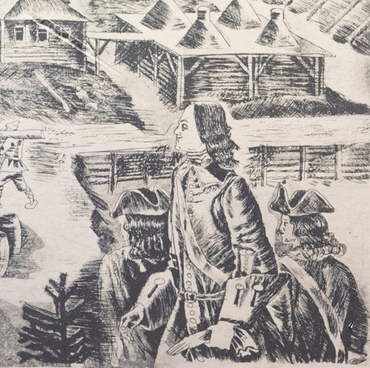Marble is a crystalline metamorphic rock. Metamorphic rocks are those that were formed from other substances under the influence of high temperature, pressure, gases and aqueous solutions.
Marble has a granular structure a little bit different than granite has. Colored marbles are quite common in the nature, and their color depends on the presence of various mineral impurities. The stones are easy to process, but they are not very durable. Marble reacts badly to sudden changes in temperature, humidity, harmful gas in the atmosphere, so it is rarely used for facade decoration in Russian architecture. This stone is often used as an interior decorative material.
The marble deposit in Karelia, which has been mined since the middle of the 18th century, is located in the Northern Ladoga region, near the village of Ruskola (Ruskeala). Ruskeala marble quarries had a variety of marble colors: from snow-white to dark gray, and from light yellow-green to dark green. Marble was patterned or striped; it was easily processed and polished. However, the marble from Ruskeala also had a significant drawback: the content of harmful impurities known as pyrite crystals, which were rapidly oxidized in urban conditions, destroyed the stone. Such marble is not stable enough, and, when it is used in exterior decoration, it requires partial or complete replacement after about 50–60 years.
Marble deposits have been discovered in many regions of Russia, but the Karelian deposit was the first to be used. In 1757, a merchant Peter Martyanov organized the extraction of marble, initially in the village of Belaya Gora, and in 1807 in the village of Tivdia (now — Kondopozhsky district, the Republic of Karelia).
The Tivdian (Belogorsky) marble has more than thirty various shades: from pale pink to lilac. This material was used in the construction of St. Petersburg. The extraction of marble and its transportation was described in detail by the Academician Nikolai Ozeretskovsky in “The Journey along the Ladoga and Onega Lakes”.
In 1760, about 3,000 peasants were attributed to the Tivdian marble quarries. They lived in the settlement of Gizhozero on the left bank of the Tivdiyka river. In 1807, the Tivdian marble factory was opened, which consisted of workshops for sawing, grinding and polishing marble. In addition, a water wheel was installed on the river, which powered more than a hundred saws. The plant accepted commissions from the Kazan and St. Isaac’s Cathedrals in St. Petersburg.
There are different types of Karelian marble in the Arkhangelsk collection.
Marble has a granular structure a little bit different than granite has. Colored marbles are quite common in the nature, and their color depends on the presence of various mineral impurities. The stones are easy to process, but they are not very durable. Marble reacts badly to sudden changes in temperature, humidity, harmful gas in the atmosphere, so it is rarely used for facade decoration in Russian architecture. This stone is often used as an interior decorative material.
The marble deposit in Karelia, which has been mined since the middle of the 18th century, is located in the Northern Ladoga region, near the village of Ruskola (Ruskeala). Ruskeala marble quarries had a variety of marble colors: from snow-white to dark gray, and from light yellow-green to dark green. Marble was patterned or striped; it was easily processed and polished. However, the marble from Ruskeala also had a significant drawback: the content of harmful impurities known as pyrite crystals, which were rapidly oxidized in urban conditions, destroyed the stone. Such marble is not stable enough, and, when it is used in exterior decoration, it requires partial or complete replacement after about 50–60 years.
Marble deposits have been discovered in many regions of Russia, but the Karelian deposit was the first to be used. In 1757, a merchant Peter Martyanov organized the extraction of marble, initially in the village of Belaya Gora, and in 1807 in the village of Tivdia (now — Kondopozhsky district, the Republic of Karelia).
The Tivdian (Belogorsky) marble has more than thirty various shades: from pale pink to lilac. This material was used in the construction of St. Petersburg. The extraction of marble and its transportation was described in detail by the Academician Nikolai Ozeretskovsky in “The Journey along the Ladoga and Onega Lakes”.
In 1760, about 3,000 peasants were attributed to the Tivdian marble quarries. They lived in the settlement of Gizhozero on the left bank of the Tivdiyka river. In 1807, the Tivdian marble factory was opened, which consisted of workshops for sawing, grinding and polishing marble. In addition, a water wheel was installed on the river, which powered more than a hundred saws. The plant accepted commissions from the Kazan and St. Isaac’s Cathedrals in St. Petersburg.
There are different types of Karelian marble in the Arkhangelsk collection.



